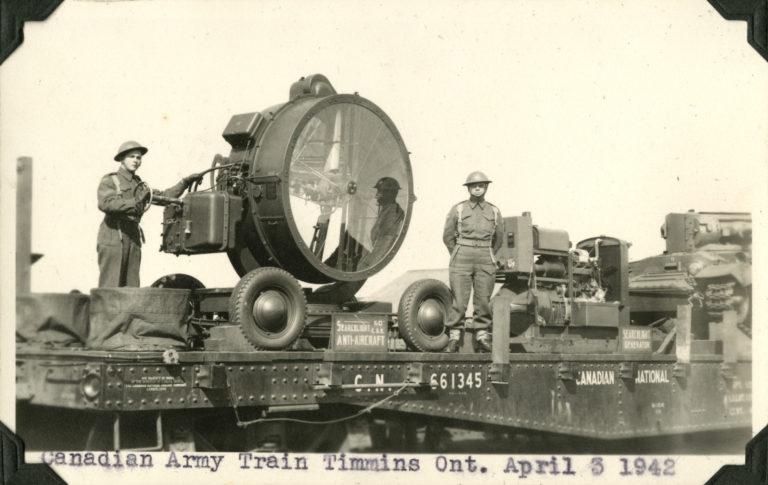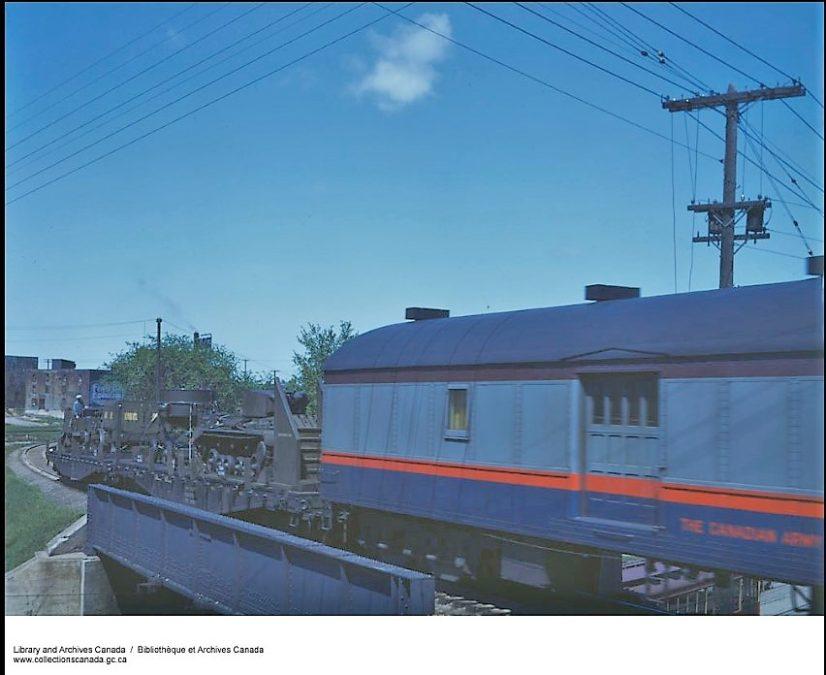Canadian Army Train rallied the public to support the war effort in 1942
On February 23 and 24, 1942, a promotional train for the Canadian Army visited our region, making stops in Cornwall, Ontario and Rigaud, Québec. In a special feature, Review Historical Contributor Shawn MacWha documents the story of the Canadian Army Train and why it was so important to the country’s war effort during World War 2. This article was suggested by a Review reader who submitted information on the train’s visit to Rigaud after reading MacWha’s historical feature on the Dominion Timber and Minerals Railway in Marelan, Québec.
By Shawn MacWha, Review Historical Contributor
The winter of 1941-42 was a dark time for Canadians. Europe was firmly in the hands of Nazi Germany and the Royal Air Force had only just managed to fight off the Luftwaffe and win the Battle of Britain. England was hungry and needed weapons, but the sea lanes back to North America were infested with German submarine wolf packs which tormented the merchant ships that were trying to keep the United Kingdom alive.
On December 7, 1941, the Japanese launched their infamous attack on Pearl Harbor, pulling a reluctant America into the war and opening the West Coast to a new threat. Only a few weeks later the British garrison at Hong Kong, which had just been reinforced with almost 2,000 Canadians, fell to the Japanese Army and the entire Allied force was either killed or captured. By Christmas Day, 290 of the Canadian soldiers who had arrived in Hong Kong the previous month were dead and more than 1,600 others were sent off to prisoner of war camps, where 264 more would die before being liberated in 1945.
Train allowed public to see soldiers and weapons first-hand
Faced with bad news in Asia and a seemingly unstoppable German army in Europe, the political and military leaders in Ottawa needed to do something to rally the Canadian people to the cause of the war. At the beginning of 1942, they settled upon a masterful public relations campaign to bolster support for the military. A 15-car-long train – advertised as the Canadian Army Train – was assembled in Ottawa to carry more than $3 million worth of ‘Made in Canada’ military equipment on a 24,000 kilometre coast-to-coast tour of the country.

Under the command of Lieutenant-Colonel J.E. McKenna, a veteran of the Great War and a popular member of the Royal Montreal Regiment, the train’s role was to provide the Canadian public with a chance to see the soldiers and weapons of their army first-hand. More practically, the train also served as a mobile recruitment centre, drawing young men and women from across the country into the ranks of the armed forces. Of equal importance, it was also a running advertisement for the sale of the Victory Bonds needed to finance the war.
Coaches were painted red, blue, French gray and maroon to honour the colours of the four Canadian Divisions that had been formed. The 65 soldiers who lived and worked aboard the train during its tour were hand-picked to represent more than 40 different units from across the country. The train usually visited two or three towns per day, setting up for three hours at a time to let people walk through the carriages and see a broad range of military equipment, most of which had never been shown in public before.
Exhibits included a Valentine Tank, a Bren Gun Carrier, a jeep, a 25-pound artillery piece, light and heavy machine guns, rifles and small arms, clothing, medical equipment, communications and signaling devices and an 800,000,000 candlepower searchlight that was visible from up to 100 kilometres away. The cars were organized into displays representing different parts of the army, including the Royal Canadian Corps of Signals, the Royal Canadian Engineers, the Royal Canadian Artillery and even the Dental and Medical Corps. Also on board was a display from the Canadian Red Cross Society that focused upon its role in sending care packages to allied prisoners of war and in and collecting blood serum to send over to Britain to help treat wounded soldiers and civilians.
Stops in Cornwall and Rigaud
The train started its tour in Ottawa on February 3, 1942 and over the next three months visited 202 different communities across the country, drawing in a remarkable 800,000 visitors at a time when the population of Canada was less than 12 million people. Residents of Eastern Ontario and Western Québec were first able to visit the train on the afternoon February 23, when it stopped in Cornwall after having come along the St. Lawrence River from Brockville.

The next morning (February 24, 1942), the train moved on to Rigaud, Québec, where more than 2,000 people, led by the mayor, came out to welcome it. Later that day it proceeded to Ste. Anne de Bellvue, where almost 5,000 people walked through the exhibits – the highest turn-out to date for the tour.
For its visit to Québec the English posters that offered information on the military equipment aboard the train elsewhere in Canada were switched to bilingual signs. On board, the 15 bilingual soldiers who normally attended to the exhibits were augmented with more French-speaking soldiers, in order to better convey their message to local citizens.
Following a visit to Montréal and the Eastern Townships, the train continued into the Maritimes, before turning around and heading westwards across the country – all the way to Vancouver. Then, circling to the east once again, the train made its way back across the Canada, stopping in towns all along the way before finally ending its tour in Montréal on May 10, 1942.
Hard days remained throughout the rest of 1942. In June the Alaskan islands of Attu and Kiska were occupied by Japanese forces, bringing the war to the doorstep of North America. Later, in August, the Canadian Army launched its ill-fated raid on Dieppe, where almost 1,000 men died in less than 12 hours on the beaches of France.
The war was not going well, but the Canadian people remained committed to the cause and by the end of the fighting more than a million Canadians and Newfoundlanders had served in the military. Of these, 45,000 never made it home.
While the Canadian Army Train certainly didn’t win the war, it did manage to win the support of the population at a time when victory was by no means certain.
Photo Gallery – Click on any photo to see it in full size






